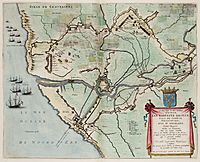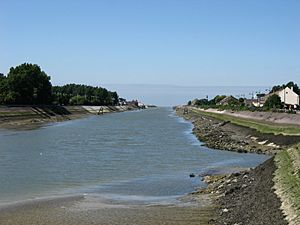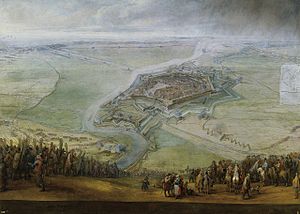Siege of Gravelines (1644) facts for kids
Quick facts for kids Siege of Gravelines |
|||||||
|---|---|---|---|---|---|---|---|
| Part of 1635 to 1659 Franco-Spanish War | |||||||
 Siege of Gravelines, 1644 by Atlas van Loon |
|||||||
|
|||||||
| Belligerents | |||||||
| Commanders and leaders | |||||||
| Strength | |||||||
| 20,000 | 2,200 | ||||||
| Casualties and losses | |||||||
| Unknown | Unknown | ||||||
The 1644 Siege of Gravelines was an important battle during the Franco-Spanish War (1635-1659). A French army fought to capture the port city of Gravelines. At that time, Gravelines was part of the Spanish Netherlands. Today, it is in the Pas-de-Calais region of northern France.
The siege started on May 28, 1644. The city surrendered to the French on July 28. Gravelines was later taken back by the Spanish in 1652. But it changed hands again in 1658. Finally, it became part of France for good in 1659, after the Treaty of the Pyrenees was signed.
Contents
Why Was Gravelines Important?
Europe's Big Rivalry
In the 1600s, two powerful families ruled much of Europe. These were the Bourbon kings of France and their rivals, the Habsburgs. The Habsburgs ruled Spain and the Holy Roman Empire.
The Habsburgs controlled lands around France. These included the Spanish Netherlands, Franche-Comté, and the Pyrenees mountains. These lands blocked France from growing. They also made France easy to invade. Even though the Bourbons were Catholic, they often supported anyone who was against the Habsburgs. This included Muslim Ottomans.
France Joins the War
From 1622 to 1630, France was busy dealing with Protestant revolts at home. But they also helped Protestant allies in other wars. These included the Dutch revolt and the Thirty Years' War (1618-1648).
In 1635, King Louis XIII of France made a deal. He agreed to divide the Spanish Netherlands with the Dutch. Then, France declared war on Spain.
Changing Battle Plans
At first, the Spanish pushed back a French attack in the Netherlands. In 1636, the Spanish went on the attack themselves. They reached Corbie in Northern France before leaving. This made France change its plans.
The French decided to focus on making their borders stronger. They captured Arras in 1640. Two years later, they took Perpignan. On May 19, 1643, the main Spanish army was defeated. This happened at the Battle of Rocroi. The French general was D'Enghien, who later became known as Le Grand Condé. After this victory, France gained ground in the important Lorraine region.
A New King and New Plans
Soon after Rocroi, King Louis XIII died. His son, Louis XIV, became king. He was only five years old. This led to a power struggle. His mother, Anne of Austria, and Cardinal Mazarin were on one side. His uncle, Gaston, duc d'Orléans, was on the other.
Orléans was said to be jealous of D'Enghien's success. He insisted that France attack French Flanders. He wanted this instead of making their gains from 1643 stronger.
Gravelines: A Key Target
The main goal for France in 1644 was to capture Gravelines. It was one end of a line of defenses. This line ran along the border between France and the Spanish Netherlands.
At the same time, the Dutch planned to attack Sas van Gent in the north. Their navy would also stop Spain from sending supplies to Gravelines. Facing these two threats, Francisco de Melo had to make a choice. He was the Governor of the Spanish Netherlands. He decided it was more important to keep the northern Flemish ports of Ghent and Antwerp. This meant Gravelines would not get help.
How the Siege Unfolded


Gravelines was hard to attack because of its location. It was surrounded by marshy ground. This meant the French needed a large army, about 20,000 soldiers. They arrived outside the town on May 28.
The Duke of Orléans was in charge, but mostly in name. The real leaders were La Meilleraye and de Gassion. La Meilleraye was the Master of Artillery. De Gassion had been D'Enghien's second-in-command at Rocroi. Both were skilled, but they struggled to work together.
Breaking Through Defenses
First, the French had to capture a small fort outside the town. It was called Fort St Philippe. It fell on June 13. After that, the siege of Gravelines itself began.
The French dug two sets of trenches. One came from the east, the other from the south. Each was overseen by one of the main commanders. La Meilleraye controlled the supplies for digging trenches. De Gassion later complained that La Meilleraye refused to share them.
A battery (a group) of 20 cannons was set up where the trenches met. They started firing on June 20. The siege moved slowly. The defenders fought off four different attacks. But on July 26, the French finally got onto the outer walls.
Surrender and Aftermath
Under the rules of war back then, if defenders surrendered once the attackers were on the walls, they could leave. They could keep their weapons and belongings. If they didn't surrender, they would be killed, and the town would be looted.
The Spanish soldiers had no hope of getting help. They had held up the large French army for two months. So, on July 28, the Spanish garrison (soldiers) "beat the chamade". This meant they signaled their surrender. They were given safe passage to Dunkirk.
After the surrender, La Meilleraye and De Gassion almost fought over who would enter the town first. La Meilleraye then went back to Paris. De Gassion stayed at Watten.
What Happened Next?
In September, the Dutch captured Sas van Gent. But this took up their entire fighting season. For the Spanish, this was a fair trade. They managed to recapture Gravelines in 1652.
The French did not get a huge victory. This was partly because of different goals in the Spanish Netherlands. France wanted its own ports to control its trade. Much of this trade was handled by Amsterdam. Amsterdam had become the richest city in Europe because of it. It was also the capital of the States of Holland. Their taxes provided over 60% of the Dutch national budget.
In 1645, the French attacked Bruges. This town was supposed to go to the Dutch in the 1635 treaty. In 1646, a planned attack on Antwerp was called off. This happened after news of a possible marriage. It was between seven-year-old Louis XIV and Maria Theresa of Spain.
Mazarin said there was no such agreement. But he admitted talks had happened. The talks suggested the Spanish Netherlands would be part of her dowry (a gift from the bride's family). Because of this, the Dutch signed the Peace of Münster with Spain in 1648. This treaty confirmed the Netherlands' independence.
Images for kids




